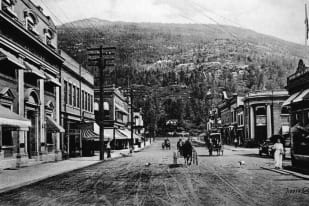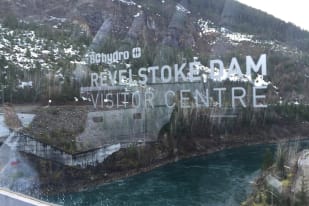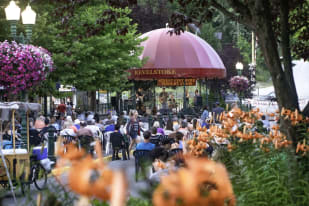3 Valley Gap Heritage Ghost Town: A Look at BC’s Abandoned Past Near Revelstoke

A Window Into the Past
Located just off the Trans-Canada Highway, 3 Valley Gap Heritage Ghost Town is approximately a 15-minute drive (22 kilometres) west of Revelstoke, British Columbia. This heritage site preserves the stories of British Columbia’s frontier days. Abandoned settlements, historic railcars, and relocated structures recreate an era when gold prospectors, fur traders, and railway workers built lives in the rugged landscape. More than a collection of old buildings, it is a reconstructed town that allows visitors to walk through history.
Gordon and Ethel Bell spent decades rescuing and restoring abandoned structures from across the province, giving them new life in this heritage attraction. Their vision transformed a quiet mountain pass into a living record of pioneer struggles, railway expansion, and the boom-and-bust cycles that shaped Western Canada. This is a place to see firsthand how early settlers lived and worked, explore antique artifacts, and step inside buildings that once stood in communities long forgotten.
The Vision Behind the Restoration
Gordon and Ethel Bell purchased the land in 1956 to create a roadside stop for travellers. Their small business gradually expanded into a large-scale effort to save British Columbia’s vanishing history. They travelled throughout the province, acquiring and moving structures to the 3 Valley Gap. What started with a few buildings grew into an entire town.
The Bells focused on authenticity. Rather than creating replicas, they salvaged original structures, preserving historical details. St. Stephen’s Church, for example, originally stood in Donald, BC, a key railway hub in the late 1800s. The Hotel Bellevue, built in 1898, was relocated from Field, BC, another railway settlement. Each structure has its own story, tied to industries that shaped British Columbia.
The Rise and Fall of Settlements in British Columbia
British Columbia’s interior saw rapid development in the late 19th century, driven by gold discoveries, railway expansion, and agricultural settlement. The gold rush of 1862 brought thousands of prospectors, but towns built during this period rarely lasted. When the gold ran out, so did the people. Some communities transitioned to farming, while others faded into obscurity.
Railways played a crucial role in shaping settlements. The Canadian Pacific Railway (CPR) linked the region to the rest of the country, spurring growth in towns like Donald and Craigellachie. However, as the railway’s needs changed, stations and worker camps were abandoned. Logging towns followed a similar pattern—thriving while resources were plentiful, then closing when demand shifted.
3 Valley Gap Heritage Ghost Town captures this cycle of boom and abandonment. Buildings from these lost communities were carefully relocated and restored, preserving a physical connection to the past that would otherwise have disappeared.
Highlights of 3 Valley Gap Heritage Ghost Town
Historic Buildings
The site includes more than 25 restored buildings, each representing a different aspect of pioneer life. The Golden Wheel Saloon shows where workers and prospectors relaxed after long days of labour. The C.B. Hume General Store, originally from Revelstoke, displays goods that would have been available to settlers. The Jailhouse, which once held lawbreakers in a remote mining town, still has its original iron-barred cells.
Antique Auto Museum
The museum features vintage automobiles dating back to the early 1900s. Highlights include a 1902 Curved Dash Oldsmobile and a 1906 Cadillac Model M. These vehicles demonstrate the transition from horse-drawn transport to early motorized travel, showcasing the mechanical ingenuity of the time.
The Railway Roundhouse
The railway was essential to settlement in British Columbia, and the Roundhouse at 3 Valley Gap preserves this history. It houses locomotives, railcars, and railway equipment, offering a rare look at early train travel. The turntable, one of the largest in North America, remains fully operational.
Relocating and Restoring History
Moving entire buildings required careful dismantling, transportation, and reconstruction. Many were in disrepair when acquired, requiring extensive restoration. The process involved reinforcing foundations, repairing roofs, and sourcing period-appropriate materials to maintain authenticity.
St. Stephen’s Church was one of the first buildings moved. Built-in 1886, it served railway workers in Donald before being abandoned when the railway moved operations to Revelstoke. The Bells transported it piece by piece and restored it to its original appearance.
Another major project was the 1902 Craigellachie School House. It once served children of CPR workers near the site where the last spike of the railway was driven. Today, it is a preserved example of early education in British Columbia.
The restoration process came with challenges. After decades of neglect, many buildings required extensive work to stabilize them. The Bells used period-specific materials to maintain authenticity. In some cases, original architectural elements were salvaged and repurposed to ensure accuracy.
Haunted Encounters and Local Legends
The site embraces its eerie atmosphere, inviting visitors to share any unusual experiences they may have had while exploring. Some guests have reported strange occurrences, and the management even encourages people to submit their stories and photographs of any unexplained activity. While no specific ghost stories are officially recorded, the combination of historic buildings, artifacts, and the quiet mountain setting gives the ghost town an unmistakable atmosphere.
Comparison to Other Ghost Towns
Unlike other ghost towns in British Columbia that remain in their original locations, 3 Valley Gap was created by relocating and restoring buildings from multiple sites. This approach differentiates it from places like Barkerville Historic Town & Park, which preserves an original gold rush settlement. While both locations offer a glimpse into British Columbia’s past, 3 Valley Gap provides a reconstructed setting where buildings from various locations are brought together in one accessible site.
Planning Your Visit
3 Valley Gap Heritage Ghost Town is a self-guided experience, allowing visitors to explore at their own pace. Informational displays provide historical context for each building, while interactive exhibits engage visitors of all ages.
Visitors can also enjoy a variety of on-site services. The Three Valley Lake Chateau, located next to the ghost town, offers over 200 rooms for those wanting to stay overnight. The property includes a restaurant that serves breakfast, lunch, and dinner. Free parking is available, and pets are welcome as long as they remain on a leash. While most of the site is accessible, some buildings may have limited access due to their historical design.
The ghost town is open from 9 am to dusk. The best time to visit is during the warmer months, as the site may have limited access during the winter. Checking the official website for updated hours and seasonal changes is recommended.
Experience History Firsthand
3 Valley Gap Heritage Ghost Town offers a rare opportunity to see and experience British Columbia’s past. This is a place to walk through authentic buildings, examine artifacts from another era, and gain a deeper understanding of the challenges faced by early settlers. The restoration work preserves stories that might otherwise be lost, making this site a valuable link to Canada’s frontier history.
A visit to 3 Valley Gap is more than a history lesson—it is a chance to step into a world shaped by resilience, innovation, and the constant push to build a future in a demanding landscape. Plan a trip, explore the preserved town, and take in a piece of the past before it disappears.




